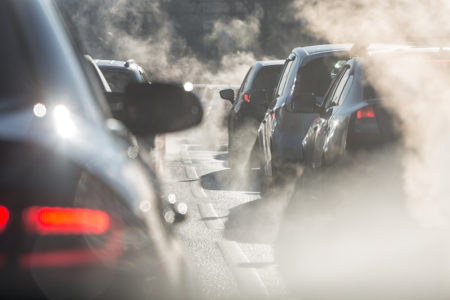
Share On Social!
The climate crisis is especially impacting Latinos and other people of color.
Despite being low contributors to the rate of emissions—toxins that are one of the main issues spurring global warming—they are experiencing worse health outcomes, due to rising temperatures and extreme weather events.
This is why advocates have been calling for environmental justice, a strategy to address climate change through a lens that focuses on those who are harmed most.
Electric cars are an emerging piece of environmental justice.
As more and more electric vehicles hit the market, experts are saying these cars can drive efforts toward environmental justice for people of color.
“The electric vehicle transition has great potential to benefit Black and Latino communities, which are disproportionately affected by fossil fuel pollution,” Andrea Marpillero-Colomina, an adjunct lecturer in urban studies at The New School, writes in an Op-Ed in The Conversation. “Carefully targeted incentives and investments can make clean cars accessible for everyone on the road, mitigate the harms caused by gas-powered vehicles and move the U.S. toward achieving energy and climate justice.”
How Do Electric Cars Advance Environmental Justice?
Communities of color are more likely to live in areas with high rates of air pollution coming from oil refineries and petrochemical plants, as well as gas-powered cars.
Exposure to these toxins can harm health.
“People who live in these neighborhoods experience higher levels of exposure to toxic emissions such as benzene, mercury and sulfuric acid than those who don’t live near these industries,” Marpillero-Colomina writes. “They also have higher rates of heart disease, cancer and asthma.”
The main concern when it comes to burning gasoline in cars is that they emit PM2.5 (pollution particles measuring 2.5 micrometers or less).
Most PM2.5s come from fumes that billow out of large smokestacks, car tailpipes, and other sources that release harmful gasses. From there the tiny particles will enter people’s bloodstream and cause deadly harm, including:
- Damaging brain development
- Obesity in fetuses, children, and adults
- Lung complications
- Childhood diabetes

And its more than air pollution. The presence of oil refineries and petrochemical plants that emit these toxins will drive down the prices of homes.
“Reduced property values make it hard for families to build wealth or sell their homes and move away from toxic pollutants,” Marpillero-Colomina writes. “People of color are less likely to own cars and more likely to use public transit than their white counterparts, so they generate a disproportionately small share of motor vehicle pollution. But they suffer disproportionately large impacts.”
Electric vehicles, however, do not emit such toxins.
“In my view, making EVs and charging infrastructure accessible to all drivers is crucial for achieving clean transportation and energy justice,” Marpillero-Colomina writes.
How Is Climate Change Impacting Latinos?
Global warming is making life harder for Latinos and other communities of color.
Given current and historical emissions levels, Americans, specifically, are looking down the barrel of a hot, uncomfortable future.
Respiratory illness rates reflect this inequity, Marpillero-Colomina, which include:
- Black and Latino children in the U.S. are diagnosed with asthma at higher rates than white children.
- Latino children are almost twice as likely to die from asthmaas white children.
- For Black children the death rate from asthma is almost eight times higher than for white children.

A groundbreaking 2019 study estimated “that Black and Latino populations experience 56% and 63% more pollution respectively than their activities cause.”
Cities across the US will experience harsher extreme-weather events, see increases in daily temperatures, and some might no longer be inhabitable.
Worse, this crisis will have significantly worse repercussions on underserved groups, including Latinos. These populations will have a more challenging time dealing with future consequences, but they are already enduring its current impacts.
Experts and researchers say recent extreme weather events—such as the massive snowstorm that caused rolling blackouts throughout Texas recently—is only one part of the broader climate crisis problem.
Climate change could lead to nearly 300 cities becoming uninhabitable.
Some of America’s most significant cities face the highest risks, as most are near a coast. These urban hubs contain large populations, capital assets, and ports that influence the national economy.
What Can I Do to Help?
The main thing public leaders can do to help is to make is as easy for people to start driving an electric vehicle as soon as possible, according to Marpillero-Colomina.
“Electric vehicles have the potential to greatly reduce air pollution from transportation,” she writes. “They also are less expensive to own and operate over time.”
Moreover, she recommends:
- Eliminating “Charging deserts” by providing low-income communities with charging stations
- Providing incentive programs for used cars, not just new ones
- Expanded purchase incentives can help to steadily grow the number of EVs on the road
- Allowing special purchase incentives to ride-share drivers, who spend much more time on the road than most drivers
You can share crucial environmental information with your local leaders, too.
If you’d like to continue making a difference in your community’s sustainability practices, you can download a Salud America! Health Equity Report Card.
The report card will show you how you will see how your county is doing on various health-related conditions compared to the rest of your state and nation. The data will show how your area stacks up in air toxin exposure, respiratory hazard indices, population density, tree canopy, and job rates in the agricultural, construction, and manufacturing fields.
Email your Health Equity Report Card to community leaders. Share it on social media. Use it to make the case to for health equity where it is needed most!
GET YOUR HEALTH EQUITY REPORT CARD!
Explore More:
Air QualityBy The Numbers
24
percent
of Mexican American-nonsmokers are exposed to secondhand smoke



